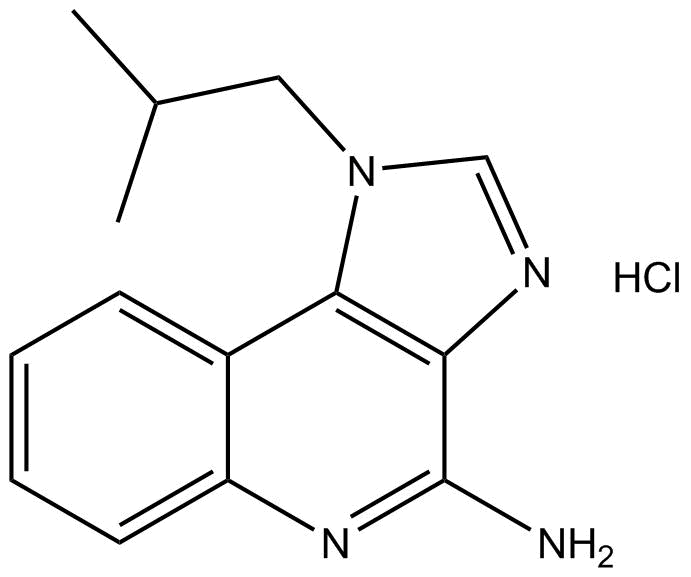Imiquimod hydrochloride
Imiquimod hydrochloride (CAS 99011-78-6) is a topically bioavailable imidazoquinoline compound, functioning as a selective Toll-like receptor 7 (TLR7) agonist in immune cells and exhibiting immune response modulation in various cellular targets. Additionally, it acts as an immunomodulator via induction of cytokine production and activation of innate immunity.
In experimental models, Imiquimod hydrochloride stimulates the production of interferon-alpha and other pro-inflammatory cytokines, with demonstrated activity in both in vitro and in vivo studies. It has been tested against a variety of cell lines and experimentally induced viral or tumor models. It can also promote the maturation and activation of dendritic cells, enhance NK cell cytotoxicity, and facilitate macrophage activation.
In pharmaceutical and biomedical research applications, Imiquimod hydrochloride is widely used for investigating antiviral and antitumor responses, as well as for studies related to external genital and perianal warts, certain types of cancer, and conditions associated with dysregulated innate immunity.
| Physical Appearance | A solid |
| Storage | Store at -20°C |
| M.Wt | 276.76 |
| Cas No. | 99011-78-6 |
| Formula | C14H17ClN4 |
| Synonyms | R 837 hydrochloride |
| Solubility | ≥3.59 mg/mL in EtOH with ultrasonic; ≥5.54 mg/mL in DMSO with gentle warming and ultrasonic; ≥7.34 mg/mL in H2O with ultrasonic |
| Chemical Name | 1-isobutyl-1H-imidazo[4,5-c]quinolin-4(5H)-imine hydrochloride |
| SDF | Download SDF |
| Canonical SMILES | CC(C)C[n]1c(-c(cccc2)c2NC2=N)c2nc1.Cl |
| Shipping Condition | Small Molecules with Blue Ice, Modified Nucleotides with Dry Ice. |
| General tips | We do not recommend long-term storage for the solution, please use it up soon. |
| Cell experiment:[1] | |
|
Cell lines |
Thioglycollate-elicited peritoneal cells from wild-type (C57BL/6) and MyD88-deficient mice |
|
Reaction Conditions |
101 ~ 104 nM imiquimod for 24 h incubation |
|
Applications |
Imiquimod increased TNF-α and IL-12p40 production in IFN-γ-treated murine peritoneal macrophages in a concentration- and MyD88-dependent manner. |
| Animal experiment:[2] | |
|
Animal models |
Female Hartley guinea pigs, 400 ~ 500 g |
|
Dosage form |
5 mg/kg Administered intravaginally every 12 h for five days beginning 12 h after genital HSV-2 inoculation |
|
Applications |
Imiquimod (5 mg/kg, intravaginally, twice daily) reduced vaginal viral titer and lesion formation in a guinea pig model of genital HSV-2 infection. Imiquimod exhibited potent anti-HSV activity in vivo due to cytokine induction and enhancement of cell-mediated responses. |
|
Note |
The technical data provided above is for reference only. |
|
References: 1. Hemmi H, Kaisho T, Takeuchi O, et al. Small anti-viral compounds activate immune cells via the TLR7 MyD88-dependent signaling pathway. Nature Immunology, 2002, 3(2): 196-200. 2. Harrison CJ, Jenski L, Voychehovski T, et al. Modification of immunological responses and clinical disease during topical R-837 treatment of genital HSV-2 infection. Antiviral Research, 1988, 10(4-5): 209-223. |
|
Quality Control & MSDS
- View current batch:
Chemical structure









